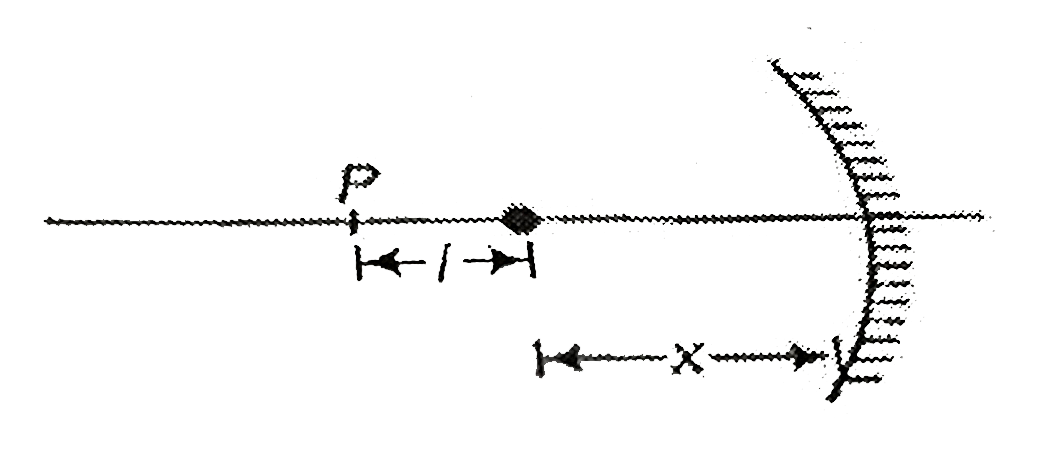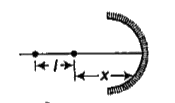A short linear object of length b lies along the axis of a concave mirror of focal length f at a distanee u from the pole of the mirror. The size of the image is approximately equal to
b(u−ff)12
b(fu−f)12
b(u−ff)
b(fu−f)2
The correct Answer is:D
To find the size of the image of a short linear object of length b that lies along the axis of a concave mirror with focal length f at a distance u from the pole of the mirror, we can follow these steps:
Step 1: Understand the Geometry
Consider the object as a short linear rod of length b positioned along the axis of the concave mirror. Let point A and point B be the two ends of the rod. The distance from the mirror's pole to the object is u.
Step 2: Use the Mirror Formula
The mirror formula relates the object distance u, the image distance v, and the focal length f of the mirror:
1f=1v+1u
From this, we can express v in terms of u and f:
1v=1f−1u⟹v=fuu−f
Step 3: Calculate the Magnification
The magnification m of the mirror is given by:
m=−vu
Substituting the expression for v:
m=−fuu−f⋅1u=−fu−f
Step 4: Find the Size of the Image
The size of the image h′ can be calculated using the magnification:
h′=m⋅h
Where h is the size of the object, which is b:
h′=−fu−f⋅b
Since we are interested in the approximate size of the image, we can ignore the negative sign (which indicates the image is inverted):
h′≈fu−f⋅b
Final Answer
Thus, the size of the image is approximately:
h′≈fu−f⋅b
---
Consider the object as a short linear rod of length b positioned along the axis of the concave mirror. Let point A and point B be the two ends of the rod. The distance from the mirror's pole to the object is u.
The mirror formula relates the object distance u, the image distance v, and the focal length f of the mirror:
1f=1v+1u
From this, we can express v in terms of u and f:
1v=1f−1u⟹v=fuu−f
The magnification m of the mirror is given by:
m=−vu
Substituting the expression for v:
m=−fuu−f⋅1u=−fu−f
The size of the image h′ can be calculated using the magnification:
h′=m⋅h
Where h is the size of the object, which is b:
h′=−fu−f⋅b
Since we are interested in the approximate size of the image, we can ignore the negative sign (which indicates the image is inverted):
h′≈fu−f⋅b
Thus, the size of the image is approximately:
h′≈fu−f⋅b
Topper's Solved these Questions
Similar Questions
(a) A short linear object of length b lies along the axis of a concave mirror of focal length f at a distance u from the pole. What is the size of the image? (b) If the object begins to move with speed V0 , what will be the speed of its image?
View SolutionA short linear object of length / lies along normal to the axis of a concave mirror of focal length f at a distance d from the pole of the mirror. The size of the image is then (nearly)

View Solution
Knowledge Check
A short linear object of length b lies along the axis of a concave mirror or focal length f at a distance u from the pole of the mirror. The size of the image is approximately equal to
Ab(u−ff)12Bb(fu−f)12Cb(u−f2)Db(fu−f)2A short linear object of length / lies along the axis of a concave mirror of focal length f at a distance d from the pole of the mirror. The approximate size of the image is
AIf(d+f)Bd+ffICIf2(d+f)2DI(d+f)2f2A short linear object of length b lies along the axis of a concave mirror or focal length f at a distance u from the pole of the mirror. The size of the image is approximately equal to
Alfd−fBd−flfClf2(d−f)2D(d−f)2f2l
A short linear object of length b lies on the axis of a concave mirror of focal length F at a distance u from the pole. The length of the image will be
View SolutionA very small object of length a is kept along the axis of a concave mirror of focal length y at a distance x from its pole. Approximate size of the image is
View SolutionA short linear object of length l lies on the axis of a spherical mirror of focal length f, at a distance x from the mirror. Then, the length of the image (P) so obtained will be

View SolutionA short linear object of length l lies on the asix of a spherical mirror of focal length f, at a distance x from the mirror. Then, the length of the image (P) so obtained will be

View SolutionWhat is the size of the image when a short linear object of length b lies along the axis of a concave mirror of focal length f at a distance u from the pole.
View Solution
